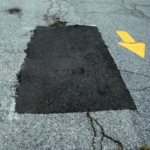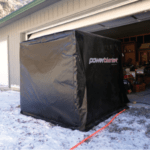Winter Road Maintenance
Winter Road Construction
Typically, it is unwise to do any major structural winter road maintenance in the cold winter months. Many professional paving companies joke that the best time to do winter repairs is in the summer. Winter road construction is not so much dictated by the season, but rather by the temperature. Warmer states have much longer active road construction periods than states with cold winters. Without special engineering permission, most states prohibit paving in conditions below 45-50°F (for example asphalt conditions must be 50° and rising in Utah). Never install asphalt or concrete on a frozen subbase; this will only ensure additional work for you when the conditions improve and you have to redo the job.
Emergency Pothole Repair
For temporary repairs such as potholes use cold mix asphalt. If the temperature is below the recommended level and it is an emergency, cold mix asphalt will work. During this cold weather repair, remove all ice, moisture, and debris from the affected area using a heat source. Keep in mind, this repair is meant to be temporary and should be permanently remedied when conditions improve
Winter Road Repairs: Crack Sealing
Crack sealing is actually preferred in colder months because pavements expand and contract with seasonal temperature changes. Consequently, cracks and joints are expanding and contracting when the pavements move. Crack sealing is a preventative winter road maintenance practice meant to extend the life of pavement. Since cracks on the pavement surface allow water and incompressible materials such as sand, dirt, and other debris to enter the pavement structure, these cracks can dramatically accelerate deterioration and weakening. Sealing cracks prevents further deterioration of the pavement and, when properly executed, can extend the life of the pavement anywhere from 6 months to 4 years.
Crack Sealing Tips
- As recommended with the pothole repair, clear the crack of moisture, dirt, debris, vegetation and chemical deicers to make the sealing more effective, use a heat lance and/or compressed air. If using a heat lance take care not to burn or scorch the pavement and the place the sealant before the pavement in the crack cools to allow for the best adherence of the crack fill materials.
- Seal all cracks from 1⁄4 inch to 1 inch in width the entire length of the crack. Cracks smaller than 1⁄4” will not retain sufficient sealer to flex in the cold. Cracks greater than 1” will sag and possibly prematurely fail without the installation of HMA or backer rod.
- When repairing cracks, fill the entire crack and level any affected area to ensure a smooth and level pavement surface.
- Apply the sealant or repair material only when the sealant or repair material is within the manufacturer’s recommended application temperature. Special care must be taken to assure that the sealant temperature does not exceed the manufacturer’s recommendations; otherwise the polymers may be destroyed therefore reducing the sealant performance.
- Keep in mind that more sealant is not always better. Over applying sealant material can lead to problems when paving over with HMA or bleeding up through the seal or paving application.
- New sealants are not designed to be “road glue”. They are very sticky and have tremendous bonding power; however, they were not made to “hold the road together”. Crack sealing has one objective: to prevent water from further damaging roads. Sealing “buys time” and saves money by delaying the expense of major reconstructive pavement work.
Powerblanket can help with Winter Road Maintenance
Whether you need a means for protecting temperature-sensitive materials in storage, or you need a heating solution for onsite temperature maintenance, the Powerblanket Hot Box will do the job. This versatile heating solution accommodates remote-location use, job site heating, the transporting of temperature sensitive materials. The revolutionary design of Powerblanket Hot Boxes provides uniform heat to all materials stored inside. This reduces the chance of having any hot and cold spots. If stored properly; chemicals, industrial products, and temperature sensitive materials will last longer and be more effective.
Frequently Asked Questions
What are winter road treatments?
Winter road treatments include anti-icing and de-icing methods, where anti-icing involves applying a liquid solution to prevent snow and ice from bonding to the pavement, and de-icing involves removing ice and snow after they have formed.
What do they put on roads in the winter?
In winter, roads are treated with substances like sodium chloride, magnesium chloride, and calcium chloride, which help to enhance traction and lower the freezing point of water on road surfaces.
What is considered road maintenance?
Road maintenance encompasses activities such as preserving road quality, maintaining road shape, and ensuring proper drainage, as well as performing spot improvements to maintain accessibility.
What is sprayed on roads in winter?
Salt brine is commonly sprayed on roads in winter as an anti-icing agent to prevent snow and ice from bonding to the road surface, effectively working down to temperatures as low as -6 degrees Fahrenheit.
The Powerblanket Hot Box is the perfect solution for your bulk material heating needs.






